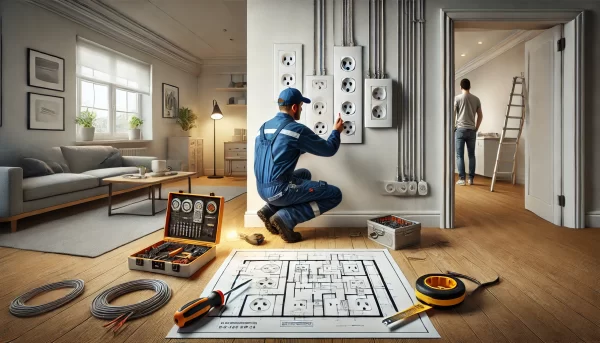
Adding electrical outlets and power points is essential for improving convenience, functionality, and safety in homes and businesses. With the increasing number of electronic devices, appliances, and smart technologies in modern spaces, the demand for well-placed outlets has grown. Whether you’re renovating, building a new home, or simply upgrading an existing system, installing additional outlets ensures you meet current and future energy needs.
This guide explores why adding outlets is important, factors to consider during the process, and how it fits into broader electrical planning and renovation projects.
Why Adding Electrical Outlets Is Necessary
Electrical outlets are a vital part of any space, providing access to power for everything from household appliances to modern devices like smart speakers and electric vehicle chargers. However, many older homes lack a sufficient number of outlets, leading to over-reliance on power strips and extension cords. This not only creates clutter but also poses safety risks such as tripping hazards or electrical fires.
By adding outlets, you ensure your home is equipped to handle modern demands while improving safety and aesthetics. Whether you’re planning a full renovation or upgrading specific areas, additional outlets make daily life more convenient and future-proof your electrical system.
Considerations for Adding Electrical Outlets
Adding outlets may seem straightforward, but there are several important factors to keep in mind. Proper planning ensures the outlets are functional, safe, and suited to your specific needs.
Placement and Spacing
When planning new outlets, consider the layout of your home and where outlets will be most useful. High-traffic areas like kitchens, living rooms, and home offices often require more outlets, while outdoor spaces may need weatherproof options for lighting or tools.
Additionally, ensure that the spacing of outlets complies with local building codes, which often require outlets to be installed every 12 feet in living areas.
Renovation Projects
Adding outlets is a common part of renovation projects, especially in older homes where the existing electrical system may be outdated. During renovations, it’s crucial to assess the capacity of your current electrical panel to determine whether it can handle additional outlets. Proper renovation considerations also include planning for future upgrades or smart technologies, ensuring your system is flexible enough to accommodate growing energy needs.
Safety Standards
Ensure all new outlets are installed by a licensed electrician to meet safety standards. This includes using ground-fault circuit interrupter (GFCI) outlets in areas prone to moisture, such as bathrooms and kitchens.
Adding Outlets During a Renovation
Upgrading Existing Systems
When renovating, you may find that your current electrical system lacks the capacity for modern demands. Adding outlets during a renovation is the perfect opportunity to upgrade wiring, install a new electrical panel, or incorporate additional circuits. This ensures that your system can handle the increased load safely and efficiently.
Incorporating New Technologies
Renovations also allow you to integrate outlets designed for specific technologies, such as USB charging ports or outlets compatible with smart home systems. These features enhance convenience and align with the needs of modern lifestyles.
Adding Outlets in New Builds
Adding outlets in a new build offers unparalleled flexibility since you can design the electrical system from scratch. Thoughtful planning during the construction phase ensures your home or business is equipped to handle both current and future electrical demands.
Strategic Planning
During electrical planning for new builds, work closely with your electrician to determine optimal outlet placement. Consider factors such as furniture arrangement, appliance locations, and high-use areas. Pre-installing outlets for potential future needs, like electric vehicle charging stations or home offices, adds long-term value.
Energy Efficiency
New builds offer the opportunity to integrate energy-efficient technologies, such as outlets connected to smart energy systems. This ensures your home operates efficiently while minimizing energy waste.
Outlets and Smart Home Integration
Adding outlets is an essential step when integrating smart home technologies. Smart devices often require additional power points for hubs, sensors, and other components, making it crucial to plan for these needs in advance.
Supporting Smart Devices
Smart home systems rely on a robust electrical setup to function effectively. Installing outlets with built-in smart features, such as Wi-Fi connectivity or dimming capabilities, enhances the functionality of your automation system. By incorporating outlets designed for smart home automation, you ensure seamless integration of modern technologies.
Expanding Capabilities
As your smart home grows, the demand for strategically placed outlets will increase. Planning for outlets in locations like walls, ceilings, and outdoor areas ensures you’re prepared to expand your automation system in the future.
Benefits of Adding Outlets
Adding outlets offers several advantages, from improving convenience to enhancing safety. Here’s why this upgrade is a worthwhile investment:
Enhanced Convenience
Additional outlets eliminate the need for extension cords, creating a cleaner and more organized space. They also allow you to use multiple devices simultaneously without overloading a single outlet.
Improved Safety
Overloading outlets can lead to overheating and electrical fires. By installing additional outlets, you distribute the load more evenly, reducing the risk of accidents.
Future-Proofing Your Home
Whether you’re planning for smart home technologies, new appliances, or additional occupants, having extra outlets ensures your home is ready for future needs.
Conclusion
Adding electrical outlets and power points is a practical upgrade that enhances the functionality, safety, and convenience of your home or business. Whether part of a renovation, new build, or smart home integration, thoughtful planning ensures the outlets meet your current needs while preparing your space for the future.
By considering renovation goals, smart technologies, and electrical planning from the start, you can create a versatile and efficient electrical system. Work with a licensed professional to design and implement the ideal setup for your property, ensuring it meets safety standards and aligns with your lifestyle.
